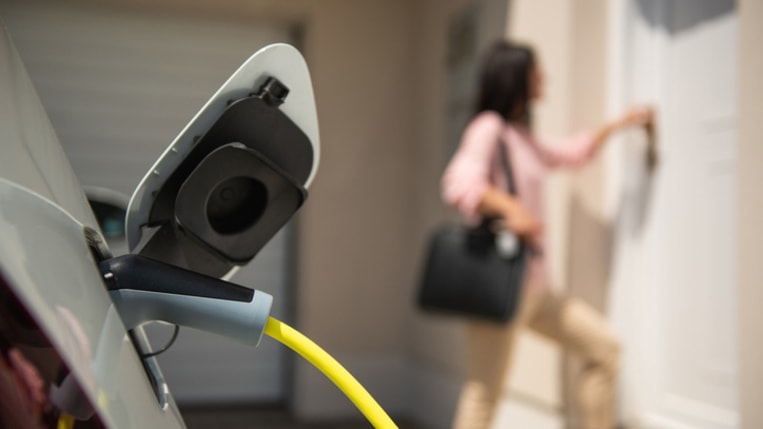
BBB Tip: What to know about installing a home car charger

(Getty Images)
Updated September 24, 2025 to reflect new information regarding electric vehicle tax credits.
As electric vehicles (EVs) become increasingly popular, keeping them charged and ready to go is a top priority for owners. The Better Business Bureau offers essential tips to consider before purchasing and installing a home charger for your EV.
What you'll learn:
-
The benefits of installing a home EV charger and how it can save you time and money compared to public charging.
-
Key factors to consider before installation, such as electrical capacity, costs, permits, and choosing the right charger.
-
Practical tips for safe installation, smart usage, and maximizing efficiency when charging your EV at home.
Investing in a home charger can be a smart move for EV owners. Although public chargers are more common, they aren't always conveniently located and may come with lines or time limits. Charging at home offers unparalleled convenience, especially overnight when electricity rates are typically lower.
Upgrading to a higher-level home charger can significantly save time. While most EVs come with a Level 1 charging cable that takes up to 20 hours to fully recharge using a 120-volt outlet, a Level 2 home charger uses a 240-volt outlet and can recharge your vehicle in just 3 to 8 hours.
While the initial cost of a home charger may not always be considered when purchasing an EV, it can save significant time and money in the long run.
Tips for installing and using a home car charger:
- Find out if your home can support a charger. Before purchasing a home car charger, have a licensed electrician assess your home’s electrical capacity to ensure it can handle the additional load. This is crucial for safety and efficiency. They can assess your home to ensure it can support a circuit for your charger and tell you whether you need any permits. Some homes may require an upgrade to their electrical panel to support the charger. This can be an important step to avoid overloading circuits. Older homes might not have the capacity to support a 240v outlet, so your installation costs could increase if you need to upgrade your wiring or dig a trench on your property.
- Know your budget. Home chargers require an upfront investment. However, you’ll likely save money on public charging fees and the cost of gasoline – and you’ll save time. Some things to consider:
- Kelly Blue Book (KBB) estimates about $2,000 for both the charger and installation and provides a formula to calculate how much you might spend to charge at home.
- This video from Cars.com shows some factors that could affect your installation cost.
- Consumers may receive a tax credit if they install a home charger. It's important to note that these credits could be reduced or phased out soon. If you’re considering a purchase, check the latest IRS guidance to see what incentives are still available and whether it makes sense to move forward sooner rather than later.
- Hire an expert. Electric work is no joke. If you’re not a professional, it can be dangerous to attempt it yourself. Ensure a licensed and experienced electrician installs the charger to comply with local electrical codes and safety standards. Your car manufacturer may have a recommended installation resource, or you can use BBB.org to find licensed, trusted electricians.
- Pick the right charger. Chargers come in different levels: the higher the amperage, the faster the charge. The faster the charge, the higher the rate. Level 1 chargers use a standard 120-volt outlet and are slower, while Level 2 chargers require a 240-volt outlet and charge significantly faster. You’ll probably want something more than a Level 1 charger, but investing the extra money in a Level 3 may not be necessary, especially if you’re charging overnight or your driving habits and charging needs don't require something higher.
- Place the charger in the right location. Install the charger in a convenient location, typically in the garage or driveway, where the charging cable can easily reach your vehicle. If installed outdoors, ensure the charger is weather-resistant or has adequate protection from the elements.
- Plan to charge at night. Many utilities have lower rates overnight when demand isn’t as high. Use your vehicle’s or charger’s scheduling features to charge during these times to save money. You can also use apps or built-in charger features to monitor energy usage and adjust charging habits for efficiency. It’s also nice to wake up to a fully charged car!
- Know your nearest public chargers. Even if you invest in a home charger, public chargers can supplement it. Check before charging to make sure the charger is public and determine whether it has fees or time limits.
For more information
Visit BBB's Auto HQ for more auto resources and tips.
See BBB's green HQ for more environmentally-friendly and sustainability tips.
Still Need Assistance?
Contact Your Local BBB
Your local Better Business Bureau can assist you with finding businesses you can trust. Start With Trust®.
Additional Resources
Let BBB help you resolve problems with a business
Research and report on scams and fraud using BBB Scam Tracker
Learn more about the value of BBB Accreditation